CXC Home | Search | Help | Image Use Policy | Latest Images | Privacy | Accessibility | Glossary | Q&A
and Dark Energy Concepts

Galaxy Cluster Animation
QuickTime MPEG This animation shows a galaxy cluster, the largest gravitationally-bound objects in the Universe. Individual galaxies are shown in white and yellow, and the intergalactic gas is shown in red. Galaxy clusters contain as much mass as a million billion suns. The strong gravitational pull of this matter squeezes the gas and heats it to about 100 million degrees, making it only detectable in X-rays. Chandra found direct evidence for cosmic acceleration and dark energy, based on distance measurements to a sample of galaxy clusters.
[Run Time: 0:26]
Animation: NASA/CXC/A. Hobart
View Still Images of a Galaxy Cluster
QuickTime MPEG This animation shows a galaxy cluster, the largest gravitationally-bound objects in the Universe. Individual galaxies are shown in white and yellow, and the intergalactic gas is shown in red. Galaxy clusters contain as much mass as a million billion suns. The strong gravitational pull of this matter squeezes the gas and heats it to about 100 million degrees, making it only detectable in X-rays. Chandra found direct evidence for cosmic acceleration and dark energy, based on distance measurements to a sample of galaxy clusters.
[Run Time: 0:26]
Animation: NASA/CXC/A. Hobart
View Still Images of a Galaxy Cluster
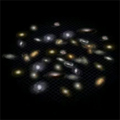
Animation of the Effects of Dark Energy
QuickTime MPEG This animation shows the expansion history of the Universe by modeling the Universe as a two-dimensional grid of galaxies. The Big Bang, shown as a flash of light, is immediately followed by rapid expansion of the Universe. This expansion then slows down because of the gravitational attraction of the matter in the Universe. As the Universe expands, the repulsive effects of dark energy become important, causing the expansion to accelerate. For clarity, the size of the deceleration and acceleration has been exaggerated.
[Run Time: 0:10]
Credit: NASA/STScI/G. Bacon
View Still Images of the Effects of Dark Energy
QuickTime MPEG This animation shows the expansion history of the Universe by modeling the Universe as a two-dimensional grid of galaxies. The Big Bang, shown as a flash of light, is immediately followed by rapid expansion of the Universe. This expansion then slows down because of the gravitational attraction of the matter in the Universe. As the Universe expands, the repulsive effects of dark energy become important, causing the expansion to accelerate. For clarity, the size of the deceleration and acceleration has been exaggerated.
[Run Time: 0:10]
Credit: NASA/STScI/G. Bacon
View Still Images of the Effects of Dark Energy
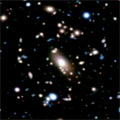
Optical/X-ray Dissolve of MACSJ1423
QuickTime MPEG This animation shows views of the galaxy cluster MACSJ1423, using optical and X-ray telescopes. The optical image, a 3-color composite from the Subaru prime focus camera, shows white and blue galaxies centered around a large elliptical galaxy. The Chandra X-ray image shows hot gas displayed in red. The mass of the hot gas is about 6 times greater than the mass of all the billions of stars in all of the galaxies in the cluster. This galaxy cluster has a redshift of 0.54, at a distance corresponding to a light travel time of 5.4 billion years.
[Run Time: 0:06]
Credit: Optical: NAOJ/Subaru/H. Ebeling; X-ray: NASA/CXC/IoA/S.Allen et al.
View Still Images of MACSJ1423.8+2404
QuickTime MPEG This animation shows views of the galaxy cluster MACSJ1423, using optical and X-ray telescopes. The optical image, a 3-color composite from the Subaru prime focus camera, shows white and blue galaxies centered around a large elliptical galaxy. The Chandra X-ray image shows hot gas displayed in red. The mass of the hot gas is about 6 times greater than the mass of all the billions of stars in all of the galaxies in the cluster. This galaxy cluster has a redshift of 0.54, at a distance corresponding to a light travel time of 5.4 billion years.
[Run Time: 0:06]
Credit: Optical: NAOJ/Subaru/H. Ebeling; X-ray: NASA/CXC/IoA/S.Allen et al.
View Still Images of MACSJ1423.8+2404

Future Expansion of the Universe with Constant Dark Energy
QuickTime MPEG This animation shows a possible future for the Universe by modeling the Universe as a two dimensional grid of galaxies. If dark energy is constant, consistent with Albert Einstein's suggestion, then the expansion of the Universe should continue accelerating until in a hundred billion years or so, only a tiny fraction of the known galaxies in the Universe will be observable.
[Run Time: 0:11]
Credit: NASA/STScI/G.Bacon
QuickTime MPEG This animation shows a possible future for the Universe by modeling the Universe as a two dimensional grid of galaxies. If dark energy is constant, consistent with Albert Einstein's suggestion, then the expansion of the Universe should continue accelerating until in a hundred billion years or so, only a tiny fraction of the known galaxies in the Universe will be observable.
[Run Time: 0:11]
Credit: NASA/STScI/G.Bacon
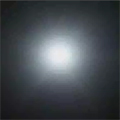
The Big Crunch
QuickTime MPEG This animation shows another possible future for the Universe, where dark energy eventually leads to a slowing of the expansion of the Universe, followed by a recollapse, the so-called "big crunch". In some ways this scenario resembles the Big Bang in reverse.
[Run Time: 0:08]
Credit: NASA/STScI/G.Bacon
QuickTime MPEG This animation shows another possible future for the Universe, where dark energy eventually leads to a slowing of the expansion of the Universe, followed by a recollapse, the so-called "big crunch". In some ways this scenario resembles the Big Bang in reverse.
[Run Time: 0:08]
Credit: NASA/STScI/G.Bacon
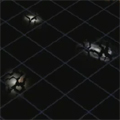
The Big Rip
QuickTime MPEG A third possible future for the Universe is the most exotic of all. As shown in this animation, if dark energy increases with time, the Universe may experience a catastrophic, runaway expansion. Within about a 100 billion years every galaxy, star and atom in the Universe would be ripped apart.
[Run Time: 0:03]
Credit: NASA/STScI/G.Bacon
QuickTime MPEG A third possible future for the Universe is the most exotic of all. As shown in this animation, if dark energy increases with time, the Universe may experience a catastrophic, runaway expansion. Within about a 100 billion years every galaxy, star and atom in the Universe would be ripped apart.
[Run Time: 0:03]
Credit: NASA/STScI/G.Bacon
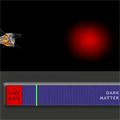
X-ray Distance Measurement Technique
QuickTime MPEG This series of stills shows the technique used to make distance measurements to galaxy clusters. Chandra's observations are used to determine the ratio of the mass of the hot gas and the mass of the dark matter in different galaxy clusters. This "gas fraction" depends on the assumed distances to the clusters, which in turn depends on the amount of matter and dark energy in the Universe. Because galaxy clusters are extremely large, the gas fraction should be the same for every cluster, and so the distances to the clusters are adjusted to satisfy this requirement. Each of the 3 illustrations shows Chandra in the top left, observing a galaxy cluster, shown in the top right (in red). The relative amounts of hot gas (in red) and dark matter (in blue) are shown at the bottom, with the green marker giving the expected, correct amount. The first illustration shows a gas fraction that is too small, implying that the distance to the cluster is too small, the second shows the correct gas fraction and distance, and the third illustration shows a gas fraction and distance that are too large.
[Run Time: 0:12]
Credit: NASA/CXC/M. Weiss
View X-ray Distance Measurement Technique illustrations
QuickTime MPEG This series of stills shows the technique used to make distance measurements to galaxy clusters. Chandra's observations are used to determine the ratio of the mass of the hot gas and the mass of the dark matter in different galaxy clusters. This "gas fraction" depends on the assumed distances to the clusters, which in turn depends on the amount of matter and dark energy in the Universe. Because galaxy clusters are extremely large, the gas fraction should be the same for every cluster, and so the distances to the clusters are adjusted to satisfy this requirement. Each of the 3 illustrations shows Chandra in the top left, observing a galaxy cluster, shown in the top right (in red). The relative amounts of hot gas (in red) and dark matter (in blue) are shown at the bottom, with the green marker giving the expected, correct amount. The first illustration shows a gas fraction that is too small, implying that the distance to the cluster is too small, the second shows the correct gas fraction and distance, and the third illustration shows a gas fraction and distance that are too large.
[Run Time: 0:12]
Credit: NASA/CXC/M. Weiss
View X-ray Distance Measurement Technique illustrations
Return to Galaxy Clusters and Dark Energy (18 May 04)


